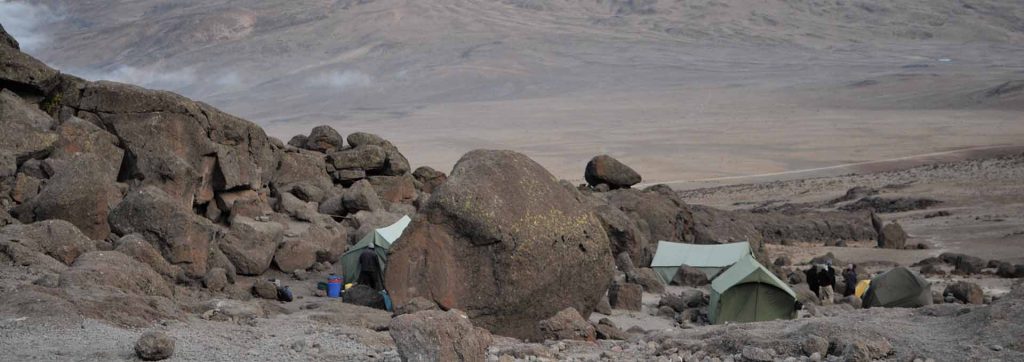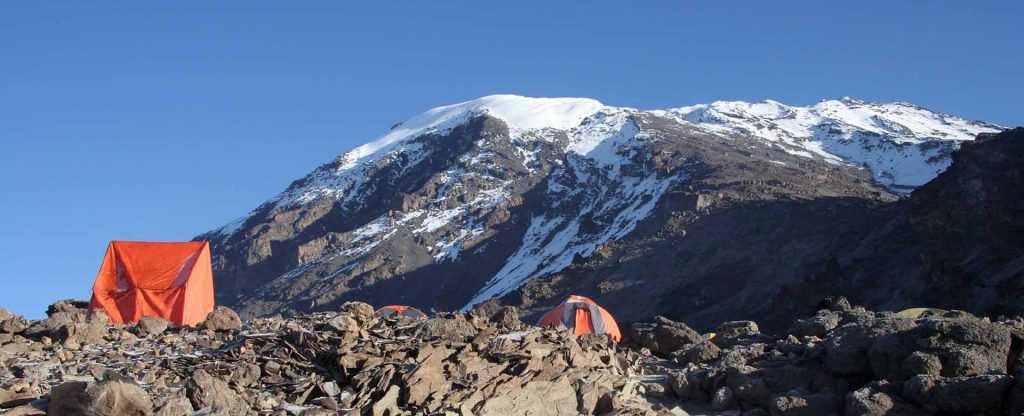Preparing For Your Kilimanjaro Expedition
The very best way to prepare for climbing to high altitude is to climb to high altitude. Although this is difficult for most people, remember that the higher the altitude you can reach and the longer the hikes you do for training, the better. Whether it be to hike 2,000 feet to the top of the local hill or climbing larger mountains further afield; just being out hiking uphill is the best. This also allows you to get used to your backpack and boots.
You should be hiking with everything in your day pack that you anticipate carrying when climbing Kili.
Running and biking are also very good and at least take you outdoors so you can test your equipment. Stair masters and climbing machines at the gym will work if outdoor hiking isn’t an option. Try not to go for short hard blasts of exercise but long sustained workouts instead. An adequate training regime is to maintain 75% of your max heart rate (220 minus your age) for an hour, three to four days a week. Remember high altitude mountain climbing requires acclimatization and that a strong mind is as important as a strong body. If you are fairly fit and choose a climbing itinerary that allows plenty of time to acclimatize you have the formula for success.

What to Pack
For the Head and Face:
- Pile or Wool hat: Bring one that covers ears, a balaclava type is excellent.
- Shade Hat: Visor hats with good brims are essential for protection from the equatorial
- Sunglasses: Essential for eye protection in the tropics, at altitude. Bring a good quality pair, preferably with an IREX protection rating of 100. Attachable side shields are necessary, or bring glacier
- Sunscreen: Bring plenty of complete sun blocks with a protection factor of 15 or more. Unless you have spent time in equatorial sun you will probably underestimate the amount necessary, so bring
- Lip Balm: With SPF rating of 15 or more.
- Bandanas: Tied around the neck they give good sun protection. Cleaning glasses, as wash clothes, They dry very quickly.
For the Upper Body:
- Upper Body Layers: For climbing the mountain we recommend you have three warm layers for the upper Items must be made of wool, synthetic or pile. Make sure all layers fit comfortably over each other and supply good insulation. A good combination is a long underwear top, a sweater, and a pile jacket or heavy wool shirt. Cotton items do not provide adequate insulation and are completely useless when damp.
- T-Shirts: Two T-shirts that you don’t mind getting dirty while on the mountain. Synthetic is
- Rain Parka: Afternoon showers are common in East Africa, especially on the Bring a good parka Gore Tex or waterproof nylon that has been “seam sealed”.
- Wind Shirt: (optional if you have Gore Tex rain gear) A nylon wind shell (not waterproof), roomy enough to fit comfortably over all upper body Gore Tex is good for both this wind shirt and for the rain coat.
- Poncho: (Optional) Quick and handy protection for body and rucksack. Poor protection in windy
- Gloves or Mittens: Wool or pile. One pair of heavy mittens and a light pair of gloves work
- Mitten Shells: One pair to go over your mittens. These are for use against the winds sometimes encountered in the crater and on the way to the
For the Lower Body:
- Quick Dry Hiking Shorts: 1 pair. Good for hiking at lower elevations on the
- Long Underwear Bottoms: One pair. Wool or synthetic.
- Wool, Bunting or Pile Pants: One pair that fit loosely and are comfortable. These are essential to be worn over the long john
- Rain Pants: Bring a good pair of rain pants of Gortex or waterproof nylon that has been “seam sealed”.
- Wind Pants: (optional if you have Gortex rain pants.) One pair. These are used often on the mountain for protection against wind. They should be breathable nylon and roomy enough to fit comfortably over wool or pile
- Tights: Lycra or polypropylene type are comfortable to hike in, provide good warmth on cool misty days, dry fast and prevent
- Undergarments: Enough for the duration of the trek.
For the Feet:
- Thin Socks: Two pairs of synthetic socks. These you will wear under heavy wool These help to prevent blisters and keep feet dry.
- Thick Socks: Three pairs of heavy wool or synthetic socks to wear for warmth with hiking
- Hiking Boots: One pair medium weight hiking boots large enough to be comfortable with one liner sock and one heavy wool or synthetic sock. When fitting boots be sure they are long enough that your toe will not strike the end of the boot when walking down hill for hours. One test is to snugly lace the boots and then strike a solid object two or three times pretty hard with the toe of the boot and see if your toes hit the If they do, try a half size larger.
- Gaiters: One pair of either high or low gaiters made of breath-able material to keep dirt and snow out of your
- Tennis Shoes or sandals: These are to wear in camp after a day of hiking.
For Sleeping:
- Sleeping Bag and Stuff Sac: On the mountain temperatures can get down to minus 10 degrees Fahrenheit at night so bring a warm
- Sleeping pad: A closed cell foam camping mattress is ok. An inflatable Therma-Rest type is more
For Drinking:
- Water Bottle: Two, one litre wide-mouthed plastic bottles at least.
- Water Treatment: We will filter your water with a Katadyn water filter. For emergencies we recommend you bring two bottles of “Potable Aqua” or a “Polar Pure”, crystal iodine in a bottle, to treat drinking water. Filtration pumps are also effective, but costly and rather
- Water Flavoring: Wyler’s lemonade, Tang, Gatoraid, etc. It is really important that you stay hydrated while at altitude for better These drink mixes are hard to come by in Tanzania so if you have one you like that makes drinking water easier we encourage you to bring some.
For Carrying Your Gear:
- Frameless Pack: A medium size comfortable pack with some support is adequate to carry personal The pack should fit properly and have a good waist belt. Side pockets are recommended for soft packs. Personal loads with camera gear, water for the day and warm clothes are often between 15 and 20 pounds.
- Pack Cover: Something waterproof to cover your pack with when hiking in the Otherwise, bring a large plastic bag to line the inside.
- Duffle/zip Bag: Medium size for mountain gear. This will go into our mountain bag that the porters will
- Duffle/zip Bag: Large enough to hold your non-mountain gear. This will meet you at the hotel after the
- Plastic Bags: Several, to double bag your sleeping bag and clothes on the It can rain every afternoon.

For Personal Health and Comfort:
- Toiletries: Bring enough for the entire trip. Keep simple and light. Few toiletries are available in Bring enough for all your needs.
- Flashlight and/or Headlamp: Important on summit day and handy in camp. Plenty of
- Pocket Knife: Simple Swiss Army type with scissors.
- Personal First Aid and Drug Kit: Please see attached recommended list.
- Trail Munchies: Although plenty of snack food is provided, trekkers like that taste of home in their Touted as an important accessory by those who have brought them in the past!
- Hot Drink Mixes: We will provide plenty of coffee, cocoa and tea, but
non-caffeinated drinks are not readily available here. Bring a supply of your favorite herbal teas.
- Towel: For wash up in camp, a small one is fine, or you can use a bandana.
- Towelettes: Such as “Wash ‘n’ Dries” for general hygiene.
- Spare Glasses: For contact wearers in dusty conditions and any eye glass wearer while on
- Umbrella: Very useful against rain and sun. Most guides use one.
Recommendations for your First Aid Kit:
We will have gauze, tape, aspirin, medicated soap, antibiotic ointment, antacid tablets, some antibiotics, pain killers, eye treatments, anaphylaxis kit, Imodium, compazine and Diamox. Because of liability problems, prescription drugs will only be dispensed in emergencies. We suggest you bring the following medical items. Please discuss this with your physician.
- Intestinal disorders: Compazine, 25mg rectal suppositories; for severe nausea, Imodium, to decrease diarrhea and cramping. Tetracycline, Cipro or Bactrim antibiotics: for initial treatment of severe diarrhea. Activated charcoal has proven to be an effective first stage treatment.
- Cuts and scrapes: It’s wise to bring a supply of “Bandaids” to treat those abrasions that sometimes
- Infections: Antibiotic ointment for cuts and abrasions. Erythromycin or Amoxicillin tablets for skin or soft tissue
- Blisters: It is wise to bring your own small supply of blister treatment items to insure that you avoid letting any blister get out of “Second Skin” and moleskin are recommended
- Headaches: Tylenol and tylenol with codeine** to help relieve possible altitude Nothing stronger than codeine should be taken for fear of masking potential severe altitude problems while on the mountain.
- Insomnia: Halcion** 15mg tablets. In high altitude mountaineering restlessness is not uncommon and sleep is very important. Halcion is a light sleeping pill, we do not recommend using any sleeping pills above 15,000 We have also found Melatonin to be very helpful for jet lag.
- High Altitude Sickness: Diamox** (acetazolamide) 250mg tablets to be taken twice a day from 13,000 feet to the This drug is widely used in high altitude mountaineering and is highly recommended.
** These drugs are recommended by Peter H. Hackett, M.D., in his American Alpine Club publication
“Mountain Sickness Prevention, Recognition and Treatment.”
Please note that while camping, you will have no access to electricity or shavers or hair dryers. In hotels, you will occasionally find 240 volt AC/55-cycle with three pin square ‘British’ type sockets therefore you will need to bring an adaptor for your appliances. In some camps you will have access to inverters to charge phones and camera batteries only.









